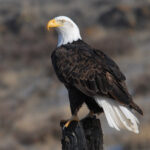Bald eagles are known for their impressive physical capabilities, including their ability to turn their heads. However, the common misconception that they can rotate their heads a full 360 degrees is not entirely accurate. In this blog post, we’ll explore the true range of motion of a bald eagle’s head and neck, as well as the factors that contribute to their exceptional visual abilities.
The Flexibility of Bald Eagles’ Necks
Bald eagles have a remarkable range of motion in their necks, with the ability to turn their heads to a significant degree. While they cannot rotate their heads a full 360 degrees, their neck flexibility is estimated to be around 270 degrees. This impressive range of motion is due to the fact that bald eagles have 14 cervical vertebrae, compared to the 7 found in humans.
The additional vertebrae in a bald eagle’s neck provide them with enhanced flexibility, allowing them to scan their surroundings for prey or potential threats. This flexibility is particularly important for bald eagles, as their eyes are relatively immobile within their sockets. The extra muscles attached to their eyes for focusing make it difficult for them to move their eyes around freely.
Bald Eagles’ Binocular and Peripheral Vision
 Image source: Pexels by Anrita Krause
Image source: Pexels by Anrita Krause
In addition to their impressive neck flexibility, bald eagles also have a highly developed visual system. Their binocular vision range, the area where both eyes can focus together, is estimated to be around 30 to 50 degrees. This binocular vision is crucial for hunting and identifying prey.
However, bald eagles’ peripheral vision extends much further, reaching approximately 110 degrees on each side. This gives them a total field of vision of around 220 to 240 degrees, which is significantly wider than the human field of vision.
Exceptional Eyesight and Color Vision
Bald eagles are not only known for their impressive neck flexibility and vision range but also for their exceptional eyesight. They can spot prey from great distances, with some estimates suggesting they can see a rabbit from over 2 miles away. This remarkable visual acuity is due to the high concentration of photoreceptors in their eyes, which allows them to detect even the slightest movements.
Furthermore, bald eagles have highly developed color vision, which is essential for identifying prey and avoiding threats. They can distinguish between different colors and patterns, giving them a significant advantage in their natural habitats.
Conclusion
While bald eagles cannot turn their heads a full 360 degrees, they possess an impressive range of motion, estimated to be around 270 degrees. This flexibility, combined with their exceptional eyesight and color vision, makes them highly effective hunters and survivors in their natural environments.
Understanding the true capabilities of bald eagles’ necks and visual systems is crucial for appreciating the remarkable adaptations that have evolved in these majestic birds of prey.



